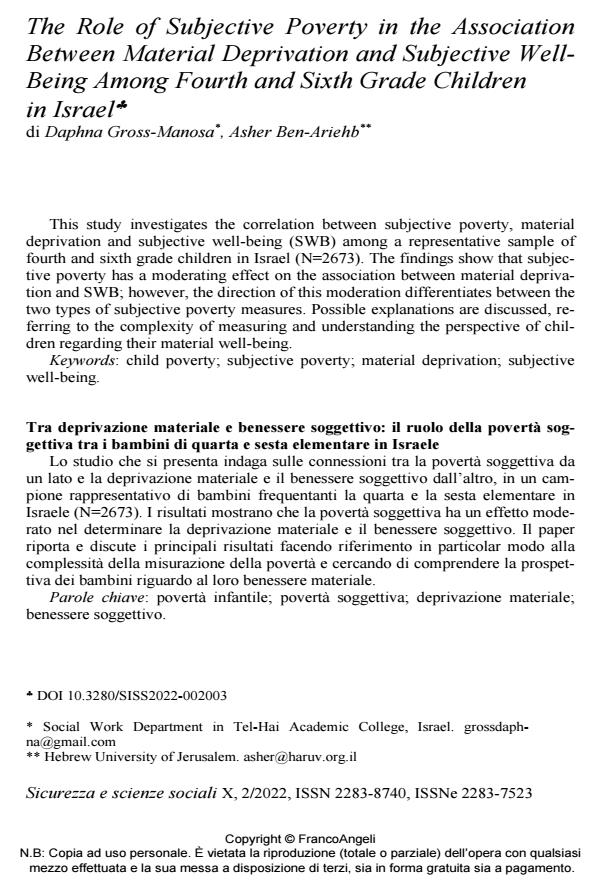The Role of Subjective Poverty in the Association Between Material Deprivation and Subjective Well-Being Among Fourth and Sixth Grade Children in Israel
Titolo Rivista SICUREZZA E SCIENZE SOCIALI
Autori/Curatori Daphna Gross-Manosa, Asher Ben-Ariehb
Anno di pubblicazione 2022 Fascicolo 2022/2
Lingua Inglese Numero pagine 20 P. 25-44 Dimensione file 231 KB
DOI 10.3280/SISS2022-002003
Il DOI è il codice a barre della proprietà intellettuale: per saperne di più
clicca qui
Qui sotto puoi vedere in anteprima la prima pagina di questo articolo.
Se questo articolo ti interessa, lo puoi acquistare (e scaricare in formato pdf) seguendo le facili indicazioni per acquistare il download credit. Acquista Download Credits per scaricare questo Articolo in formato PDF

FrancoAngeli è membro della Publishers International Linking Association, Inc (PILA)associazione indipendente e non profit per facilitare (attraverso i servizi tecnologici implementati da CrossRef.org) l’accesso degli studiosi ai contenuti digitali nelle pubblicazioni professionali e scientifiche
This study investigates the correlation between subjective poverty, material deprivation and subjective well-being (SWB) among a representative sample of fourth and sixth grade children in Israel (N=2673). The findings show that subjec-tive poverty has a moderating effect on the association between material depriva-tion and SWB; however, the direction of this moderation differentiates between the two types of subjective poverty measures. Possible explanations are discussed, referring to the complexity of measuring and understanding the perspective of children regarding their material well-being.
Lo studio che si presenta indaga sulle connessioni tra la povertà soggettiva da un lato e la deprivazione materiale e il benessere soggettivo dall’altro, in un cam-pione rappresentativo di bambini frequentanti la quarta e la sesta elementare in Israele (N=2673). I risultati mostrano che la povertà soggettiva ha un effetto mo-derato nel determinare la deprivazione materiale e il benessere soggettivo. Il paper riporta e discute i principali risultati facendo riferimento in particolar modo alla complessità della misurazione della povertà e cercando di comprendere la prospet-tiva dei bambini riguardo al loro benessere materiale.
Parole chiave:povertà infantile; povertà soggettiva; deprivazione materiale; benessere soggettivo.
Daphna Gross-Manosa, Asher Ben-Ariehb, The Role of Subjective Poverty in the Association Between Material Deprivation and Subjective Well-Being Among Fourth and Sixth Grade Children in Israel in "SICUREZZA E SCIENZE SOCIALI" 2/2022, pp 25-44, DOI: 10.3280/SISS2022-002003